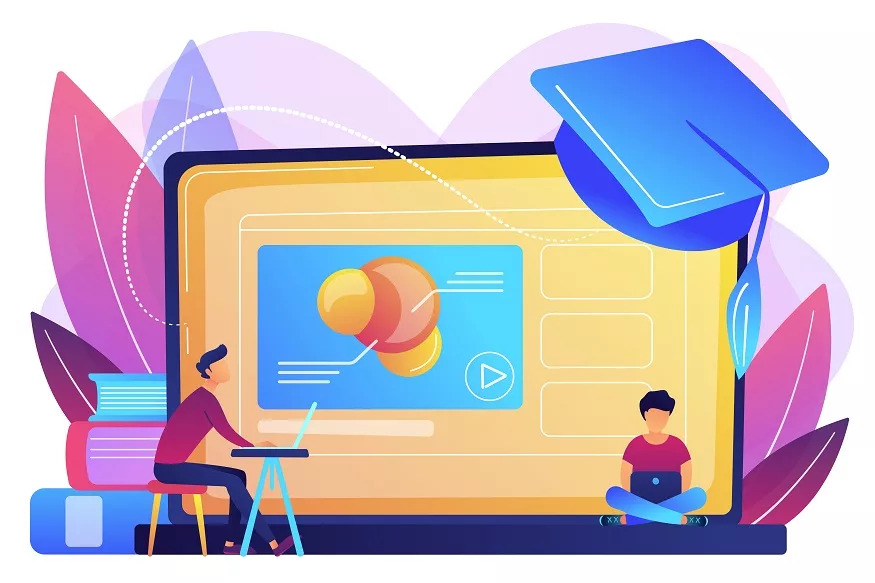What really is blended learning? If you think about the traditional classroom setting on one end of the spectrum and on the other end of the spectrum is a student learning on a computer at home. Blended learning is somewhere in the middle. How do we differentiate and individualised instruction in the classroom? Students are not engaged in lecture style instruction. Small group instruction, personal learning plans, guided practice and inquiry-based teaching all lead to a better and deeper understanding of concepts. Unfortunately, differentiation and feedback does not scale without technology.
Blended learning is about leveraging digital content to provide students with skill and practice.
Meanwhile, the teacher focuses on depth and application of concepts to teach higher order thinking skills. Blended learning in schools has the ability to create an environment where;
- Students can receive individualised, self-paced instruction.
- Teachers can provide differentiated, small-group instruction based on weekly or daily data.
- Schools can operate at a much lower cost per pupil, allowing them to reallocate resources.
This is the explanation of blended learning.
What are the Blended Learning Components?
Blended learning is a fundamental change in education design by utilising a combination of digital learning objects and active learning methods to improve the learning experience and outcomes. A teaching session created with the blended learning model uses face-to-face teaching time for activities that benefit from the most direct instruction. There is a general consensus that blended learning has three main components:
- Face to face active learning activities facilitated by an educator.
- Digital learning objects, often bite-size chunks of information.
- Structured independent study time guided by the face-to-face teaching experience.
There is no set percentage for each of these components, and the amount of ‘blend’ can vary from session to session. The move to blended learning supports the role of the educator to shift to a more facilitative role. The facilitator places emphasis on empowering young learners with the skills and knowledge. These facilitators can help children make the most of the digital materials, active learning activities, and independent study time by guiding learners through the experience.
Blended learning can be further explained by one example. Suppose a teacher showcases a presentation for her students to watch about the planets in the galaxy. With cloud-based devices, students do not need to be in school to hear the teacher’s lecture. They can watch the presentation pretty much anywhere and wherever they are, as long as they can access the content. Later, the teacher can have a discussion on the topic in school with the teacher monitoring the exchanges.
Also read : List of Improv Games for Kids
Benefits of blended learning
- Flexibility: One of the most significant benefits of blended learning is flexibility. Blended learning allows students to learn at their own pace and time, which can be particularly useful for those who have other commitments such as work or family and cannot attend traditional classroom sessions. Blended learning offers students the opportunity to learn from home or any location with an internet connection, saving time and money on commuting. Furthermore, blended learning can provide a personalised learning experience tailored to individual students’ needs, abilities, and interests.
- Engagement and motivation: Blended learning can help to increase student engagement and motivation. Whether it be through the collaboration of online and digital tools or the use of multimedia resources such as videos, audio recordings, and interactive quizzes, blended learning can create a dynamic learning situation that engages students.
- Resource and study materials: Blended learning can also enhance the learning experience by providing a wider range of resources and materials than traditional textbooks. Online resources such as e-books, podcasts, and various other articles can provide students with a more diverse set of learning supplements, helping them to develop a broader understanding of the topics they learn and broaden their perspective.
- Time-saving for teachers: Blended learning can also be highly advantageous for teachers by utilising online tools and digital resources. Teachers can save time spent on traditional school activities and administrative tasks such as evaluation and record-keeping. Blended learning can free up time for teachers to focus on more creative and engaging teaching methods. Additionally, blended learning can provide teachers with access to a world of educational resources and materials available on the internet or the cloud that they can use to enhance their teaching and develop new skills and techniques.
Also read: Benefits of Science Education in School
4 types of Blended Learning
Rotation Model
The rotation model is one of the types of blended learning that involves students rotating between traditional classroom instruction and online instruction. The rotation model can be beneficial for students who need more individualised instruction or who require additional time to complete online activities. Moreover, the rotation model can provide a more personalised learning experience that can be tailored to individual students’ needs.
Flex Model
The flex model of blended learning allows students to complete most of their coursework online but also includes some traditional classroom instruction. In this model, students can work at their own pace and in their own time using online resources and digital tools. Teachers provide support and guidance through online communication and virtual office hours.
Enriched Virtual Model
The enriched virtual model is one of the types of blended learning and is similar to the flex model but includes some traditional classroom instruction. In this model, students complete most of their coursework online but also attend some in-person classes or activities. The enriched virtual model can be beneficial for students who need a more flexible approach to education but also benefit from in-person instruction.
Online Driver Model
The online driver model of blended learning allows students to complete all their coursework online, with minimal or no traditional classroom instruction. In this model, students work at their own pace and in their own time, using online resources and digital tools. Teachers provide support and guidance through online communication and virtual office hours.
There are several different types of blended learning that can be used in educational settings each type of blended learning has its own benefits and challenges and can be tailored to meet the needs of individual students
Also read: How to choose right ICSE school in Hyderabad for 11th and 12th
At EuroSchool, we focus on combining traditional classroom instruction with online and digital learning, blended learning can provide a more personalised and effective approach to education.











